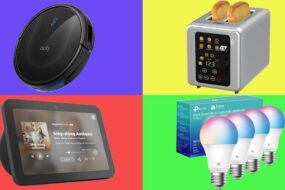
In an era where smartphones have seamlessly woven themselves into the fabric of daily life, the horizon promises even more amazing advancements. As technology accelerates, the next generation of mobile devices is set to transcend current boundaries, introducing innovations that will revolutionize how we communicate, work, and engage with the world around us. From groundbreaking display technologies and enhanced artificial intelligence to unprecedented connectivity solutions, the future of smartphones is not just about smarter devices—but about creating entirely new experiences. Join us as we explore the forthcoming mobile technologies that are poised to redefine the landscape of personal and professional interaction.
Table of Contents
- Foldable and Flexible Displays Transforming User Experience
- Advancements in Battery Technology for Longer-Lasting Devices
- The Rise of 5G and Beyond Enhancing Connectivity and Speed
- Artificial Intelligence Integration for Smarter Functionalities
- Enhanced Security Features Protecting user Data
- Sustainable Materials and eco-friendly Manufacturing Practices
- In Conclusion

Foldable and Flexible Displays Transforming User Experience
The advent of foldable and flexible display technology marks a pivotal shift in the smartphone landscape, offering users unprecedented versatility and innovation. These displays seamlessly blend the portability of conventional smartphones with the expansive screen real estate typically reserved for tablets, enabling a more immersive and adaptable user experience. Imagine unfolding your device to enjoy a cinematic viewing experience or folding it back into a compact form for effortless portability—this versatility caters to both entertainment enthusiasts and professionals on the go.
Beyond aesthetics, foldable displays enhance functionality by supporting multi-tasking in ways previously unattainable. Users can run multiple applications side by side, drag and drop content between screens, and customize their workspace to suit individual preferences. This adaptability not only boosts productivity but also personalizes the interaction, making each device a unique extension of the user’s lifestyle. Additionally, advancements in hinge mechanisms and durable materials have addressed earlier concerns regarding longevity and reliability, ensuring that foldable smartphones are as robust as they are innovative.
| Feature | Traditional Smartphones | Foldable Displays |
|————————|————————|—————————|
| Screen Size | 5.5″ – 6.5″ | 6.0″ – 8.0″ when unfolded |
| Portability | Highly portable | flexible portability |
| Multi-tasking | Limited | enhanced with dual screens|
| Durability | Fixed structure | Advanced hinge technologies|
| User Customization | Standard layouts | Dynamic, adaptable interfaces|
As foldable and flexible displays continue to evolve, they are set to redefine the boundaries of mobile technology. By merging form and function, these innovative screens not only elevate the aesthetic appeal of smartphones but also unlock new possibilities for interaction and productivity. As manufacturers refine these technologies, the future promises devices that are not only smarter but also more attuned to the dynamic needs of their users.
Advancements in Battery Technology for Longer-Lasting Devices
As smartphones continue to evolve with more powerful processors and high-resolution displays, the demand for longer-lasting batteries has never been greater. Recent advancements in battery technology are addressing this need by introducing innovative materials and designs that significantly enhance energy density and efficiency. Solid-state batteries, for example, replace the liquid electrolyte with a solid, reducing the risk of leaks and increasing the overall lifespan of the battery. This breakthrough not only allows devices to run longer on a single charge but also contributes to safer and more durable smartphones.
Another promising growth is the integration of graphene into battery cells. Graphene’s extraordinary conductivity and strength enable faster charging times and greater energy storage capacity. Smartphones equipped with graphene-enhanced batteries can achieve full charges in a fraction of the time compared to traditional lithium-ion batteries, ensuring that users spend less time tethered to power outlets. Additionally, advancements in battery management software optimize energy usage, further extending battery life by intelligently regulating power distribution based on user habits and application demands.
Comparison of Emerging battery Technologies
| Technology | Energy Density (Wh/kg) | Charging Time | lifespan (Cycles) |
|——————–|—————————|——————–|———————–|
| Solid-State | 300 | 45 minutes | 1000+ |
| Graphene-Enhanced | 250 | 15 minutes | 800 |
| Lithium-Sulfur | 400 | 60 minutes | 700 |
| Silicon-Anode | 350 | 30 minutes | 900 |
These cutting-edge battery technologies are paving the way for smartphones that are not only more powerful but also more reliable and user-friendly. As research and development continue to push the boundaries of what’s possible, consumers can look forward to devices that offer unparalleled performance without the constant worry of battery depletion.
The Rise of 5G and Beyond Enhancing Connectivity and Speed
The advent of 5G technology marks a significant leap in mobile connectivity, offering unprecedented speeds and reduced latency that are set to transform the way we interact with our devices. With download speeds up to 100 times faster than its predecessor, 5G enables seamless streaming, rapid data transfers, and enhanced real-time interaction. This enhanced performance paves the way for innovative applications such as augmented reality (AR), virtual reality (VR), and the burgeoning Internet of Things (IoT), creating a more connected and interactive user experience.
Looking beyond 5G, researchers and engineers are already exploring the potential of 6G technology, which promises to push the boundaries even further. 6G aims to achieve ultra-high speeds, perhaps reaching up to 1 terabit per second, along with improved energy efficiency and greater reliability. These advancements will support emerging technologies like holographic communications, advanced AI integration, and smart cities, where interconnected devices seamlessly collaborate to enhance urban living.
To better understand the progression from 4G to the anticipated 6G, consider the following overview:
| Technology | Speed | Latency | Key Features |
|---|---|---|---|
| 4G | 100 mbps | 50 ms | Mobile internet, HD streaming |
| 5G | 10 Gbps | 1 ms | IoT integration, AR/VR support |
| 6G | 1 Tbps | 0.1 ms | holographic communications, smart cities |
As we stand on the cusp of these technological advancements, the future of mobile connectivity promises not only faster speeds but also smarter, more efficient networks that will redefine our digital interactions and everyday experiences.

Artificial Intelligence Integration for Smarter Functionalities
As smartphones evolve, the integration of Artificial Intelligence (AI) becomes pivotal in enhancing user experiences and expanding device capabilities. AI-driven features enable devices to learn user behavior, anticipate needs, and provide personalized interactions.From intelligent voice assistants that manage daily tasks to predictive texting that streamlines communication, AI ensures that smartphones are not just tools, but intuitive partners in everyday life.
One of the standout areas where AI is making significant strides is in photography.Advanced image recognition algorithms allow cameras to automatically adjust settings for optimal lighting and composition, recognize subjects, and suggest artistic enhancements. Additionally, AI-powered security features, such as facial recognition and biometric authentication, offer robust protection while maintaining seamless access for users.
AI also plays a crucial role in optimizing device performance and battery management. By analyzing usage patterns, AI can intelligently allocate resources, ensuring smoother multitasking and longer battery life without compromising on functionality. Moreover, AI-driven applications can predict and pre-load frequently used apps, reducing load times and enhancing overall efficiency.
| AI-Powered Feature | Description |
|———————-|———————————————|
| Intelligent Camera | Auto-adjust settings for perfect shots |
| Voice Assistants | manage tasks via natural language commands |
| Predictive Text | Suggests words for faster, accurate typing |
| Biometric Security | Enhances protection with facial ID |
| Battery Optimization | Extends battery life thru smart usage |
As AI continues to advance, the future of smartphones promises even smarter functionalities, making devices more responsive, secure, and tailored to individual needs.
Enhanced security Features Protecting User Data
As smartphones evolve, so do the threats targeting user data.Future mobile technologies are prioritizing enhanced security features to safeguard personal information against increasingly refined cyber threats. biometric authentication is set to become more advanced, utilizing multi-factor systems that combine fingerprint scanning, facial recognition, and even iris scanning to ensure that only authorized users can access their devices.
Encryption technologies are also reaching new heights,with quantum-resistant algorithms on the horizon.these next-generation encryption methods will protect data not just today, but also against future attempts to decrypt information using more powerful computational techniques. Additionally, on-device AI is being integrated to detect and neutralize potential threats in real-time, providing a proactive layer of security that adapts to emerging vulnerabilities.
| Security feature | Description |
|————————–|————————————————–|
| Multi-Factor biometrics | Combines fingerprint, facial, and iris scanning |
| Quantum-Resistant Encryption | Protects data against future decryption methods |
| On-Device AI Threat Detection | Real-time identification and neutralization of threats |
| Secure Enclaves | Isolated areas within the device for sensitive data |
Privacy-centric operating systems are also gaining traction, giving users greater control over their data and permissions.These systems ensure that apps access only the information necessary for their functionality, minimizing the risk of data breaches. With these enhanced security measures, the future of smartphones promises a safer and more secure user experience, building trust and protecting the invaluable personal data of millions worldwide.
Sustainable Materials and Eco-Friendly Manufacturing Practices
As the smartphone industry evolves, sustainability has become a cornerstone of innovation. future mobile technologies are embracing sustainable materials such as recycled aluminum, bio-based plastics, and responsibly sourced rare earth metals. These materials not only reduce environmental impact but also enhance device durability and aesthetics. Manufacturers are increasingly opting for materials that are both eco-friendly and high-performance, ensuring that the next generation of smartphones meets the demands of environmentally conscious consumers.
Eco-friendly manufacturing practices are equally pivotal in shaping the future of mobile technology. Companies are adopting energy-efficient production processes, minimizing waste through advanced recycling techniques, and utilizing renewable energy sources in their factories. Additionally, the implementation of circular economy principles allows for the refurbishment and recycling of devices, significantly lowering the carbon footprint associated with smartphone production. By prioritizing sustainable manufacturing, the industry is not only mitigating its environmental impact but also setting new standards for corporate responsibility.
| Sustainable Element | Description |
|—————————|——————————————————|
| Recycled Aluminum | Reduces mining impact, lightweight and durable |
| Bio-Based Plastics | Derived from renewable sources, biodegradable |
| Renewable Energy Usage | Solar and wind power powering manufacturing plants |
| Circular Economy Initiatives | Refurbishing and recycling devices to extend lifecycle |
in Conclusion
As we stand on the brink of a new era in mobile innovation, the future of smartphones promises to be both exciting and transformative. From augmented reality integrations and foldable displays to AI-driven functionalities and enhanced connectivity, the next generation of mobile technologies is set to redefine how we interact with the world around us. While challenges remain in terms of accessibility and sustainability, the relentless pace of technological advancement ensures that smartphones will continue to evolve, seamlessly blending into every facet of our daily lives. Embracing these upcoming developments with curiosity and adaptability will allow us to fully harness the potential of tomorrow’s mobile landscape, shaping a connected and dynamic future for all.





















